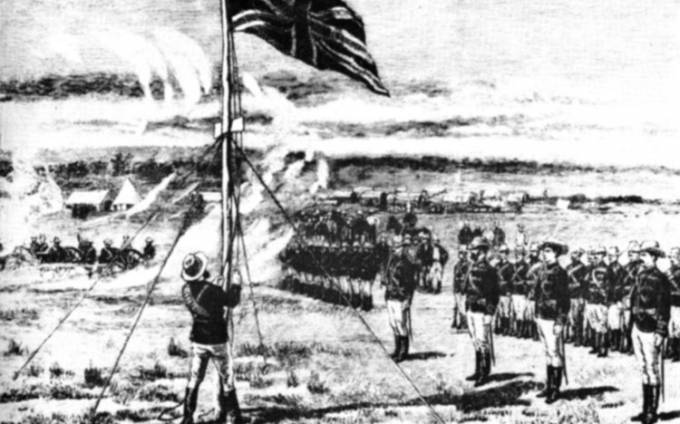Hoisting the flag of dispossession

Elliot Ziwira At the Bookstore
With Zimbabwe’s 40th birthday as an independent nation fast approaching, it is crucial to reflect on how the contest for our heritage began about 130 years ago.
In “The Chimurenga Protocol” (2008), Nyaradzo Mtizira avers that contestations for heritage in Zimbabwe started on September 12, 1890, when the “Pioneer Column” hoisted the Union Jack on Harare Hill in Salisbury and “in the name of Queen Victoria, took possession of Mashonaland, and all other unpossessed land in South-Central Africa that it should be found desirable to add to the Empire”.
Both the basis for possession and the blatant claim that there could be “unpossessed” land in a country with inhabitants, that could simply be usurped because it was “desirable” to do so, are interesting moot points at the level of both law and social justice.
The imperatives for colonialism cannot be fully understood in the absence of the human worth theory where the view is that some beings are superior to others because of race. It is this aspect that causes the challenges prevailing in postcolonial Zimbabwe as portrayed in “The Chimurenga Protocol”.
The tangible aspects of heritage relate to the physical and material gains or lack thereof, whereas the intangible relates to the spiritual, psychological and moral phenomena. The physical aspects of dispossession are reflected in the spiritual and psychological morass permeating both the fictional experiences depicted in the novel, and the ‘crisis’ arising from the post-2000 Fast Track Reform Programme.
The framing of identities of coloniser and colonised, responsible for the challenges central to the fictional experiences captured in the book, is rooted in Hegel’s (2004:80) view that: “From the earliest historical times, Africa has remained cut off from all contacts with the rest of the world; it is the land of gold, forever pressing upon itself, and the land of childhood, removed from the light of self-conscious history and wrapped in the dark mantle of night”.
The reference to Africa as a backward abode of children, despite its mineral wealth, created a rush in the Western world for a piece of this “Dark Continent” where colonialists fancied themselves “wanderers on a prehistoric earth that wore the aspect of an unknown planet” and be “the first of men taking possession of an accursed inheritance” (Joseph Conrad in “Heart of Darkness” cited in Achebe, 1977, 1983:5).
In “The Autobiography of Kingsley Fairbridge” (1927), Fairbridge writes: “I felt dreamy and far-away; my body seemed light, but I breathed heavily as we breasted the slopes. Suddenly the thought came to me, ‘Why are there no farms? Why are there no people?’ It came to me again and again, ‘Why are there no farms here?’”.
The European’s image of Africa as an “accursed inheritance” inhabited by “prehistoric” men (Achebe, 1973, 1983), or with “no people” at all (Fairbridge, 1927:29), is telling of the way the African is perceived, and how the issue of his heritage, as Mtizira contends, should be viewed.
Ngugi wa Thiong’o succinctly puts it across in “Wrestling with the Devil” (2018) when he writes, “The African is an animal . . . But I err in saying the African was considered an animal . . . Africans were worse than animals, because they asserted their humanity in the very threats they posed to settlerdom.”
The idea, as both Wa Thiong’o and Mtizira affirm, is not to worry more about what the European thinks or perceives Africans to be, but for them to assert their humanity and tell the settler in his face that settlerdom is up.
Even when he knows that he is going to be hanged, the young fighter in the novel asserts his freedom; his people’s freedom and the reclamation of heritage that will come with it. Calling Cecil John Rhodes’ emissaries, Mason and Cummins “settlers”, he tells them that the indigenous people want their “ancestral land back”.
Mtizira puts it that though such tough talk may appear dangerous, or taboo even, it is necessary in the fight for heritage. As the European makes claim through conquest, the African knows that loss of land, is the end to his livelihood.
Cummins is aware of this African philosophy as he tells Mason that the British’s decision to settle goes against the grain of peace, because “the background of traditional Shona society is deeply rooted in agriculture”.
They were able to trade peacefully with the Portuguese since the 1500s, for the reason that the visitors “understood that the indigenous people of this land were inextricably tied to their heritage”. In this vein, heritage is both tangible and intangible.
In the tangible instance, material inheritance is involved, where economic considerations come in, and with them the relationship between donors and heirs is bolstered; with the heir also motivated to build on his share and pass on an even better heritage to future generations.
Mason reflects on how he could “secure this stolen land permanently for (his) kith and kin”, because he is aware that “the settlers had a short window of opportunity to enrich themselves before the indigenous people reclaimed their noble heritage”.
He is aware that altruistically, he should pass on the land, not only to his own descendants, but to white progeny, for that is what heritage is all about. Yet, he is determined to see to it that the indigenous beneficiaries of the same heritage remain poor.
It is such contestations of heritage where others get more, and those presumed to be inferior get nothing, which leads to the psychological pangs associated with lack; and is blamed on ancestors, in the case of those left with nothing (Segalen, 1999). It becomes an issue of legacy (Sousa, Silva and Patrao, 2010).
There are always psychological and emotional issues involved in relation to tangible heritage, which is why the issue of land, as the basis for improvement of livelihoods, should be addressed as is depicted in “The Chimurenga Protocol”.
Ideologically, and strategically, Mtizira borrows Cummins’ voice to drive the point home on how blacks look at the issue of dispossession: “They insist that by depriving them of their livelihood on their land, we are stripping them of their dignity,” because of “forced eviction”.
This psychologically affects them, hence, their “demands for compensation in the light of their unceremonious eviction from their land”, are valid.
It is this thorny issue of compensation that impedes effective land reform efforts. Mtizira’s resolute view is that in terms of heritage, and how it impacts on the well-being of future generations, the land is supreme.
Because the land is not just a geographical space, it has to be read as such; in its broader context. The land is a source of wealth, pride, identity and spiritual connectedness
(Zhuwarara, 2001). This multifarious aspect of the land is central to the contestations impeding collective heritage in Zimbabwe, and as such, new lenses are required to correct past wrongs. The intangible aspect of heritage in the novel, is illustrated through spirituality. Heritage here becomes a contestation of belief systems, and how they impact on, or are influenced by the land issue.
To Africans the land is considered “mother”, therefore, it cannot be sold, bought or owned (David Lan, 1985). And as the abode of the ancestors it has a spiritual link Zhuwarara (2001). To Africans, loss of land equates to loss of dignity.
Without their land they are naked. Through Cummins Mtizira reinforces the African’s ideology on the spiritual link between black people and their land. Cummins informs Mason that “land has always been the spiritual nexus of life for the indigenous Zimbabwean”. It is not through ignorance, therefore, that supremacist whites destroyed the spiritual heritage of black people. It was a deliberate ploy to break them through loss of confidence in their African-ness.
Magosvongwe, Nyamende and Gwekwerere (2013) posit that the Shona’s lexicon is awash with phrases pertaining to the spiritual link between the land and the ancestors. They have phrases like “ivhu rinorwa nenguva yaro” (the spirits fight in their own time), ivhu rakatsamwa (the spirits are not happy), muwanikwa (indigene), mubvandiripo (illegitimate child), muuyi (settler), mwana wevhu (child of the soil), mupambevhu (usurper of land)” (Magosvongwe, Nyamende and Gwekwerere, 2013).
The Shona lexical reference above is articulated in “The Chimurenga Protocol” through the freedom fighter’s rant against “settlers” (vauyi) and “Operation Mwana Wevhu” (Operation child of the soil).
In the liberation struggle of the 1970s (Second Chimurenga), the phrase “mwana wevhu” (child of the soil) was used as a rallying point for nationalism. Phrases such as ivhu rinotora (the soil takes its own), ivhu ratiseka (we are misfortune’s victims) and rukuvhute, (umbilical cord, which Cummins makes reference to), all express spiritual links to the land. Therefore, loss of spiritual connectedness equates to loss of life, because anything that angers the spirits is detrimental to Africans.
Gods are central to the African story, and, as collective memory recalls, could be consulted in times of strife through their oracles and mediums. The chief in the traditional milieu could speak directly with the spirits, for he was the custodian of societal mores and values.
Chigwedere (2014:22) makes the observation that the chief’s installation involved entrusting his fathers’ country to him by linking him to the soil. At his installation, he was handed over “a kilogramme or two of the soil picked from his chiefdom”, so that he would be able to “defend it and look after it well” with the help of his ancestors.
In the African story, therefore, chiefs, spirit mediums and shrines were crucial in the spiritual connection between the dead and the living, and each man, each family or community lived in communion with the gods. There were gods of war, gods of rains and good harvest, gods of fairness and justice, gods of the land and gods of protection during times of strife. And all this was connected to the land.
Mtizira recollects the centrality of land in the intangible heritage key to Africans’ way of life.
He deliberately gives Cummins a thorough knowledge of the indigenous people’s religious beliefs, because it was this information that was used against blacks during the First Chimurenga and afterwards.
Realising that spirituality is key to the struggle “awe-inspiring individuals”, like Mbuya Nehanda and Sekuru Kaguvi, “who towered over the battlefield and motivated the fighters of the Chimurenga to feats of heroism against the settlers and the British forces”, were captured and hanged.
Chigwedere complements the essence of spirituality to Africans and how settlers dealt with the issue when he notes: “The agents of colonialism were left in no doubt that the Resistance War called Chimurenga was called for by the Shona national spiritual authorities with Murenga at the apex. But they also observed that these ancestral spirits operating through human mediums, organised the whole war through the Chiefs” (Chigwedere, 2014:7).
The settler authorities from then on declared war on “Shona traditional religion” and instructed that “whoever claimed to be a medium of a national spirit such as Chaminuka, Nehanda, Kaguvi or Mukwati, should be shot on sight” (ibid).
After alienating Africans from their culture by projecting it as a quintessence of evil (Fanon, 1967) and capturing their shrines, Europeans enforced their own Christian God on the indigenous people, and installed themselves as the new gods.
These are the gods that play havoc on the postcolonial state of Zimbabwe as depicted in Nyaradzo Mtizira’s “The Chimurenga Protocol”.









Comments